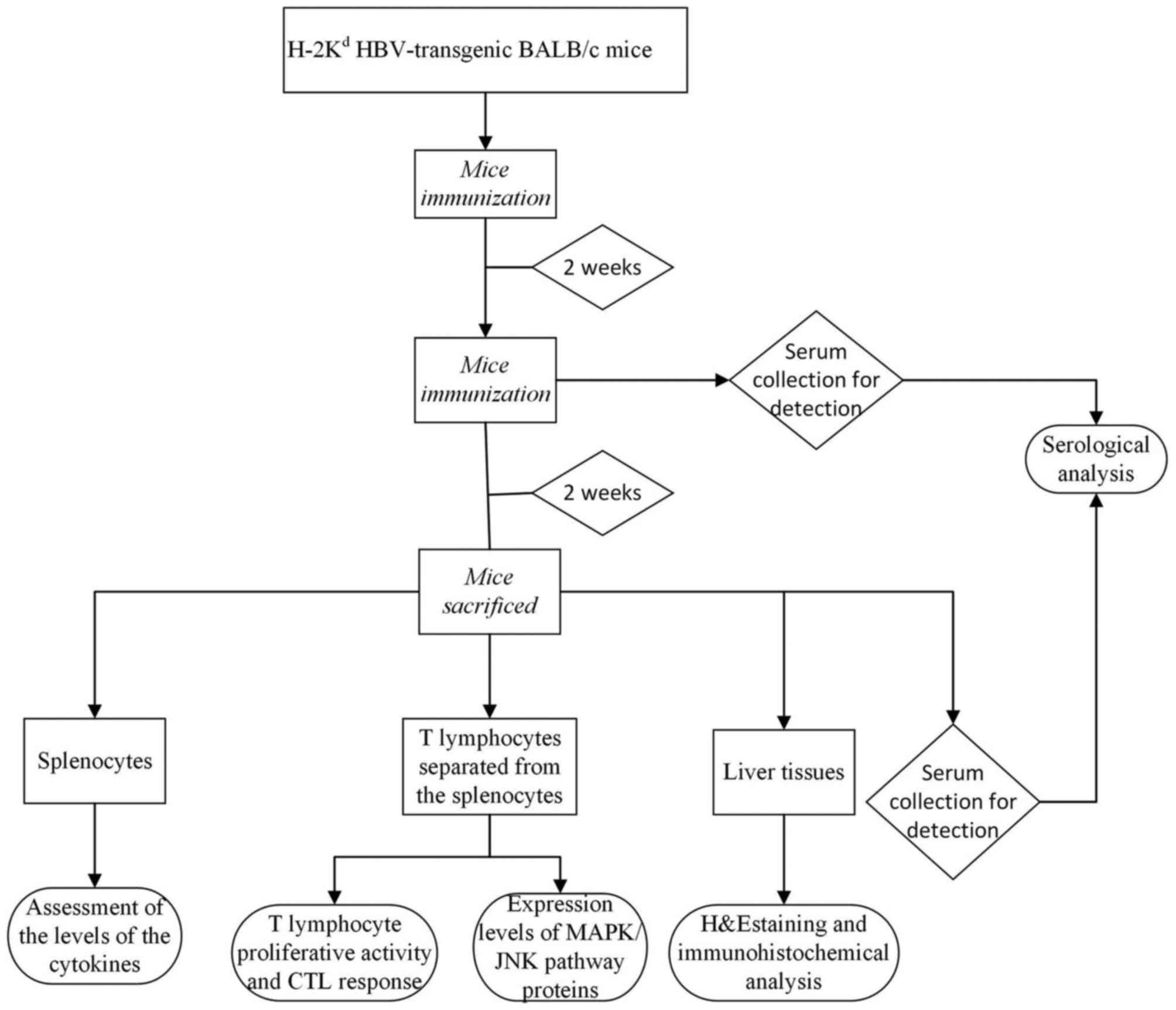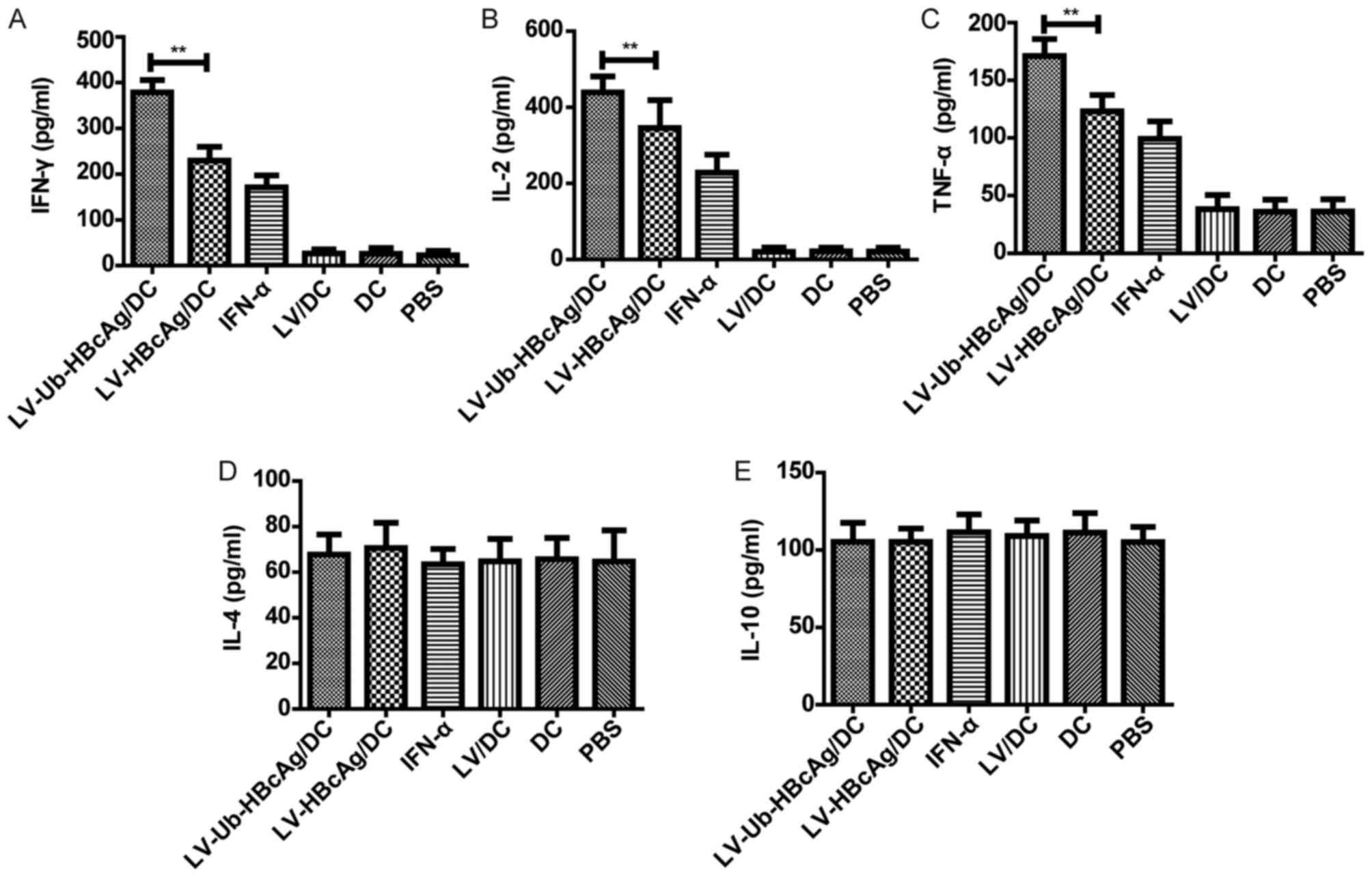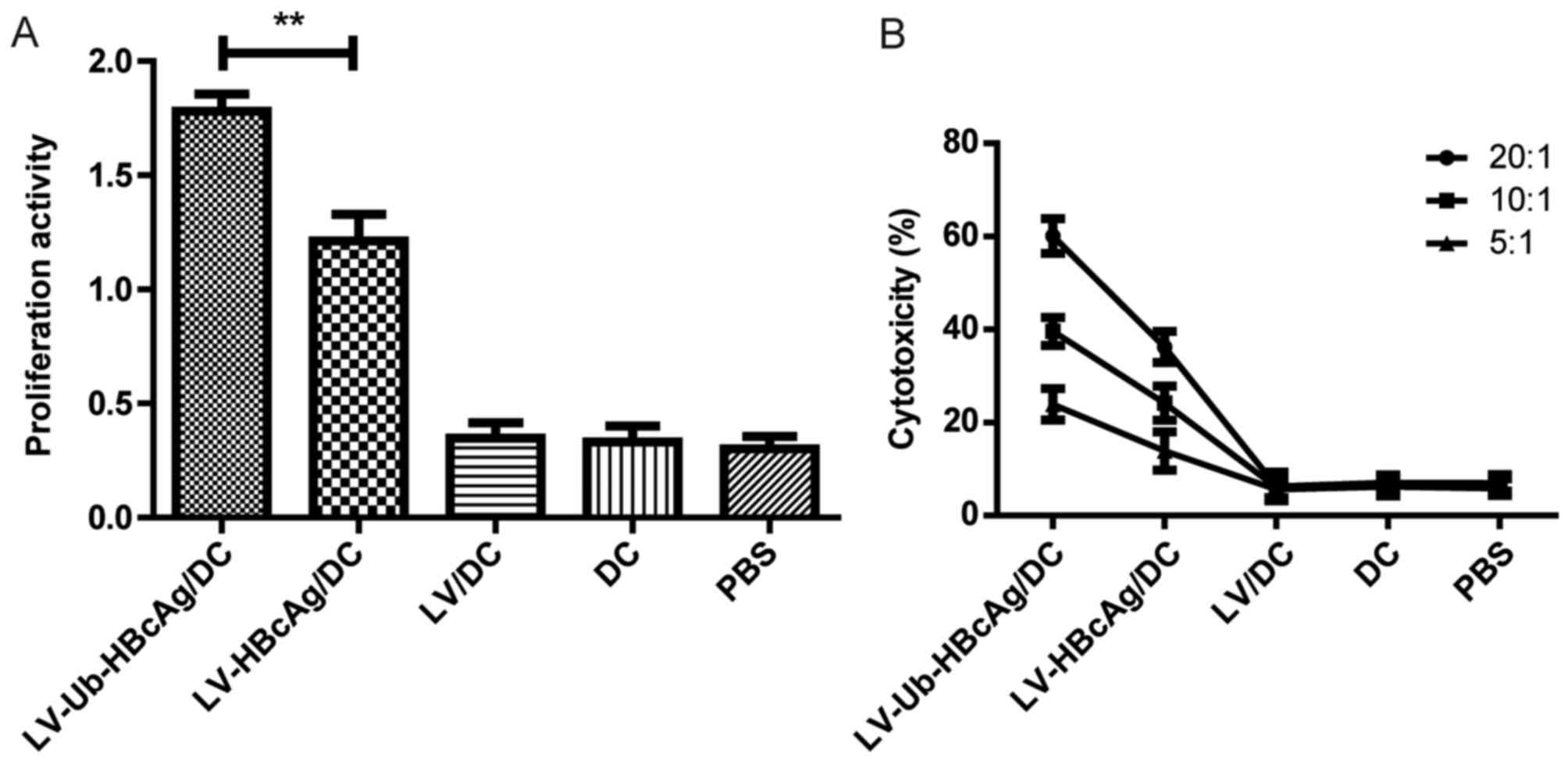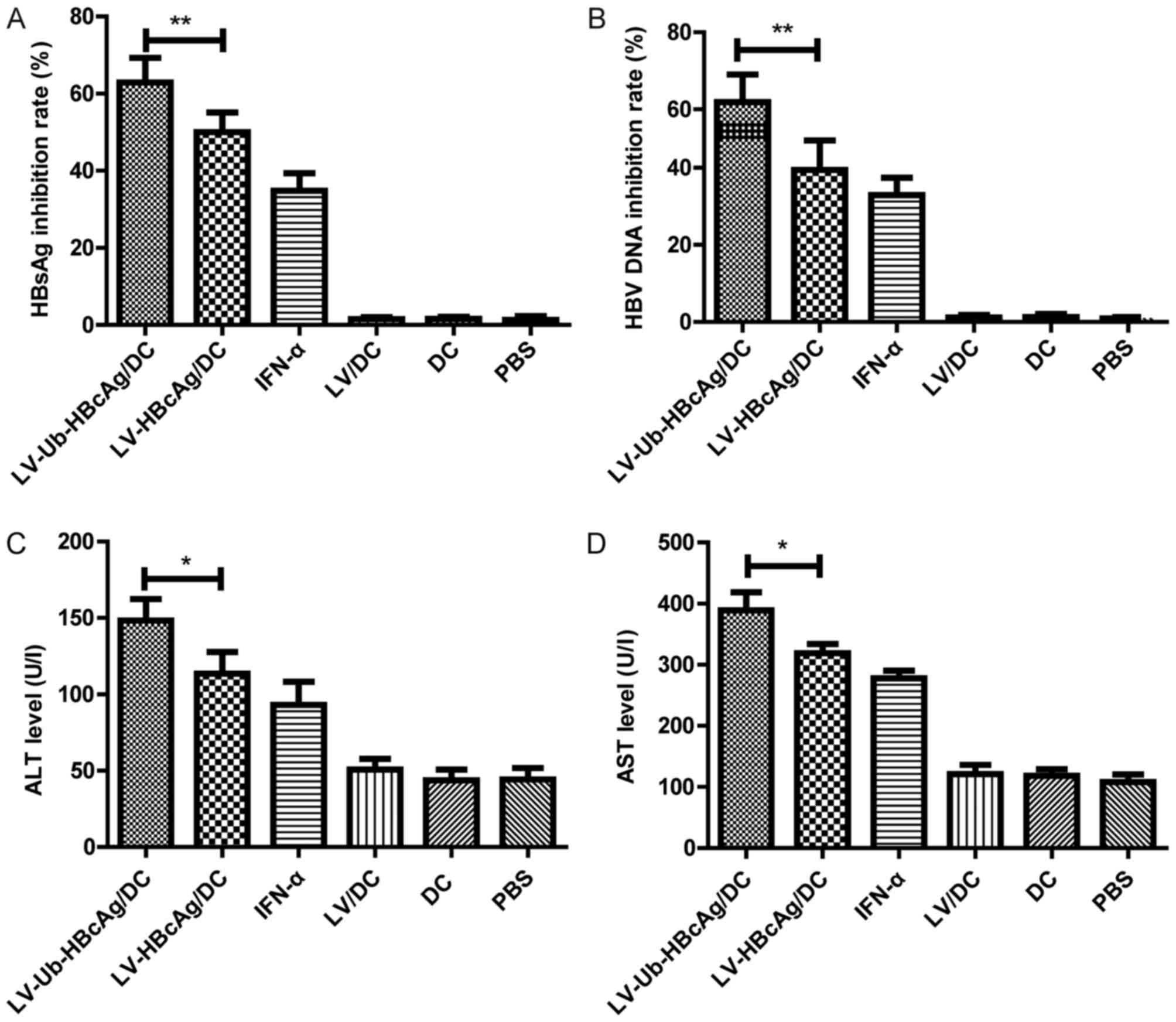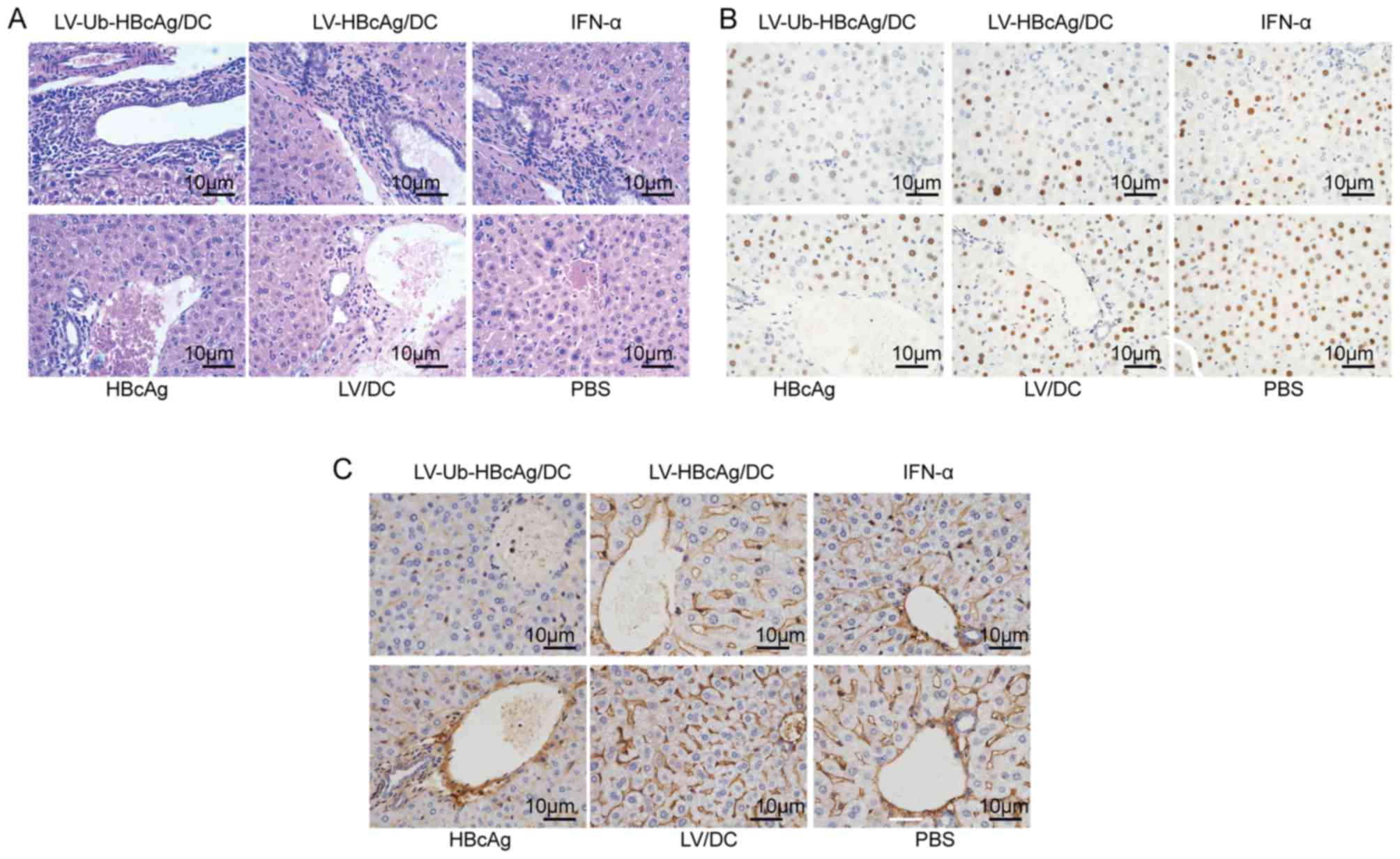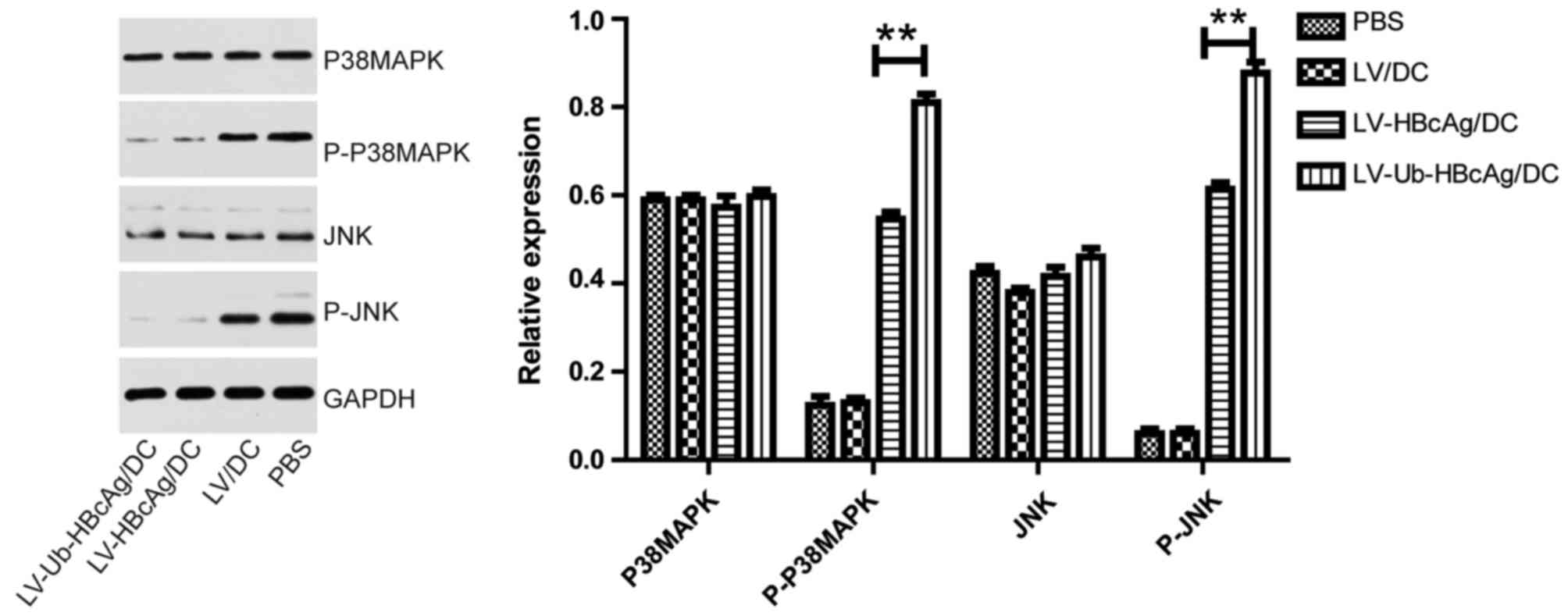Immunization with lentiviral vector‑modified dendritic cells encoding ubiquitinated hepatitis B core antigen promotes Th1 differentiation and antiviral immunity by enhancing p38 MAPK and JNK activation in HBV transgenic mice
- Authors:
- Published online on: September 14, 2018 https://doi.org/10.3892/mmr.2018.9487
- Pages: 4691-4699
Abstract
Introduction
It is reported that ~250,000,000 individuals worldwide currently have chronic hepatitis B (CHB) infection and are at risk of developing liver cirrhosis, hepatic decompensation and hepatocellular carcinoma (1–3). Furthermore, CHB infection can be life-threatening in certain cases (1–3). Viral replication and host immune responses have been shown to determine the clinical outcomes and viral persistence in patients with CHB (4,5). The eradication of HBV infection and life-long anti-HBV immunity can be monitored following the acute infection period of HBV, which occurs through the development of a robust innate or adaptive immune response (6,7). CD4+ T cell priming and subsequent development of effective CD8+ cytotoxic T lymphocyte (CTL) responses contribute to viral clearance (8). However, patients with CHB have weak or functionally impaired CD4+ and CD8+ T cell immune responses (4). Consequently, novel immunotherapeutic strategies are required to enhance HBV-specific T cell responses.
Dendritic cell (DC)-based therapeutic vaccines are essential in linking DCs and T lymphocytes and provide approaches to reactivate HBV-specific host immunity against HBV. As the most dominant antigen-presenting cells (APCs) (9), DCs are the main cells involved in antigen presentation and activation of T cells, which are important in the development of adaptive immune responses. DCs can prime naïve T helper (Th) cells to polarize into Th1 or Th2 cells. Various methods have been designed to load DCs with viral antigen genes in order to induce specific immune responses, for example, peptide- or protein-pulsed DCs (10,11). However, there are certain limitations of these types of vaccine strategies, including the short duration in antigenic epitope presentation and the limited effect of the resulting immune responses. Lentiviral vectors (LVs) are mostly based on human immunodeficiency virus-l and represent effective gene carriers. LVs can stably integrate large antigenic genes into DCs, leading to the continuous expression of the related genes. Gene-modified DCs may mediate enhanced antigen-specific immune responses (12).
Therapeutic vaccines that are based on hepatitis B core antigen (HBcAg) can polarize Th1 cells and elicit high levels of HBcAg-specific CTLs in HBV transgenic mice (13,14). HBcAg-specific CTLs have been shown to suppress HBV replication and alleviate liver damage (13,14). Ubiquitin (Ub) is a conserved protein in eukaryotic cells, which serves as a signal for the target protein to be recognized and degraded through the ubiquitin-proteasome system (UPS) during proteolysis (15). In our previous study, LVs were used to encode the ubiquitinated HBcAg (LV-Ub-HBcAg), and it was demonstrated that LV-Ub-HBcAg promoted the maturation of DCs, which induced T cell polarization to Th1 cells and the production of HBV-specific CTLs in vitro (16). The present study aimed to investigate whether DCs transduced with LV-Ub-HBcAg can enhance the polarization of Th1 cells and elicit HBV-specific T cell responses in HBV transgenic mice.
Materials and methods
Mice
H-2Kd HBV-transgenic BALB/c mice (half male and half female) were obtained from the Key Liver Army Laboratory of No.458 Hospital (Guangzhou, China). They were 6–8 weeks old (20–23 g) and their characteristics were as described previously (17,18). All mice were housed under specific pathogen-free conditions (22–24°C; humidity 50–55%; 12 h light/dark cycle), with free access to food and water. in the Experimental Animal Centre of the Sixth Hospital affiliated to Shanghai Jiao Tong University (Shanghai, China). The study protocol was performed according to the guidelines established by the Laboratory Animal Ethics Committees of Shanghai Jiao Tong University.
Recombinant lentiviral vector preparation and DC transduction
The recombinant lentiviral vectors encoding Ub-HBcAg and/or HBcAg were constructed as described previously (19). The lentiviral particles (LV-Ub-HBcAg and LV-HBcAg or LV) were prepared in 293T cells (American Type Culture Collection, Manassas, VA, USA) and tittered as described previously (19). Briefly, the recombinant pLOV.UBC.Ub-HBcAg.EGFP.3FLAG vector plasmid was constructed by inserting the Ub-HBcAg fragment into the BamHI and NheI sites of the pLOV.UBC.EGFP.3FLAG plasmid (Obio Technology Corp., Ltd., Shanghai, China). The control plasmid was constructed by inserting the HBcAg fragment. Lentiviral particles of LV-Ub-HBcAg, LV-HBcAg or LV were produced by triple transfection of 80% confluent 293T cells with pLOV.UBC.Ub-HBcAg.EGFP.3FLAG, pLOV.UBC.HBcAg.EGFP.3FLAG or pLOV.UBC.EGFP.3FLAG using the pHelper 1.0 and pHelper 2.0 helper plasmids (Obio Technology Corp., Ltd.) using Lipofectamine 2000 (Invitrogen; Thermo Fisher Scientific, Inc.). Murine DCs were generated according to the protocol described by Chen et al (16). The DCs were transduced by the LVs (LV-Ub-HBcAg, LV-HBcAg, or LV) at a multiplicity of infection of 20 as described in our previous study (19).
Mice immunization
The HBV transgenic mice were randomly divided into six groups, with six mice in each group. Subcutaneous immunization of the mice was performed twice at an interval of 2 weeks with 5×105 recombinant lentiviral-transduced DCs (LV/DC, LV-HBcAg/DC, or LV-Ub-HBcAg/DC), 20,000 IU interferon (IFN)-α (Roche Diagnostics, Basel, Switzerland) or 50 µg HBcAg (CalBioreagents, Inc., San Mateo, CA, USA). Mice injected with PBS and/or untransduced DCs served as the controls (Fig. 1).
Assessment of the levels of the cytokines
The splenocytes were harvested 2 weeks following the final immunization, and were seeded in 24-well plates (2×106 cells/ml) in the presence of 10 µg/ml HBcAg. Following 72 h of incubation in RPMI 1640 culture medium (Invitrogen; Thermo Fisher Scientific, Inc.) containing 10% fetal bovine serum (FBS; Gibco; Thermo Fisher Scientific, Inc.), 100 U/ml penicillin and 100 g/ml streptomycin at 37°C in a humidified atmosphere with 5% CO2, the levels of IFN-γ, interleukin (IL)-2, tumor necrosis factor (TNF)-α, IL-4 and IL-10 in the supernatants were measured using commercial mouse cytokine ELISA kits (cat. nos. MIF00, M2000, MTA00B, M4000B and M1000B; R&D Systems, Inc., Minneapolis, NN USA), according to the manufacturer's protocols. The results are expressed as pg/ml.
Detection of T lymphocyte proliferative activity and CTL response
The T lymphocytes were separated from the splenocytes using nylon wool columns (Wako Pure Chemical Industries, Ltd., Tokyo, Japan) according to the method described previously by Chen et al (20). The Cell Counting Kit-8 (Dojindo Molecular Technologies, Inc., Kumamoto, Japan) was utilized to detect T lymphocyte proliferation. The T lymphocytes were seeded at a density of 4×105 cells/well in a final volume of 200 µl in 96-well culture plates. The cells were subsequently co-cultured with 1 µg of ConA solution at 37°C with 5% CO2. Following 48 h of incubation, 20 µl of Cell Counting Kit-8 reagent was added to the plates, and the plates were incubated at 37°C with 5% CO2 for 4 h. The absorbance was recorded at 450 nm.
P815/c cells (expressing HBcAg; Nanjing Medical University, Nanjing, China) were maintained in our laboratory (Department of Infectious Disease, Shanghai Jiao Tong University Affiliated Sixth People's Hospital) and used as target cells. T lymphocytes were used as the effector cells and incubated (RPMI1640 culture medium containing 10% FBS, 100 U/ml penicillin, and 100 g/ml streptomycin) with the P815/c cells at different effector and target (E/T) ratios (5:1,10:1, and 20:1) at 37°C with 5% CO2 for 4 h. HBcAg-specific CTL activity was determined using a lactate dehydrogenase release assay according to the protocol of the CytoTox 96® Non-radioactive cytotoxicity kit (Promega Corporation, Madison, WI, USA). The absorbance values of the sample supernatants were recorded at 490 nm. The cytotoxicity (%) was calculated as follows: [(experimental release-effector spontaneous release-target spontaneous release)/(target maximum release-target spontaneous release)] ×100% (16,21).
Serological analysis
The serum was harvested 2 weeks following the first and final immunization. Serum HBsAg and HBV DNA levels were measured respectively using Abbott kits (Abbott Diagnostics, Chicago, IL, USA) and quantitative polymerase chain reaction (qPCR; Terra PCR Direct Polymerase mix, Clontech Laboratories, Inc., Mountainview, CA, USA) (22). Primer sequences (sequences unavailable) were synthesized and provided by DaAn Gene Co., Ltd. of Sun Yat-sen University (Guangzhou, China). Fluorescence was measured using a LightCycler 600 real-time fluorescence quantitative PCR instrument (Roche Diagnostics, Basel, Switzerland). The thermocycling conditions were as follows: 93°C for 7 min; 10 cycles of 93°C for 45 sec and 55°C for 1 min; 30 cycles of 93°C for 30 sec and 55°C for 45 sec; then 40°C for 20 sec. The 2−ΔΔCq method was used to quantify the results (23). Furthermore, the levels of alanine aminotransferase (ALT) and aspartate transaminase (AST) in the serum were detected using the ARCHITECT Automatic Biochemistry Analyzer (Abbott Diagnostics, Abbott Park, IL, USA).
Hematoxylin and eosin (H&E) staining and immunohistochemical analysis of the liver
The liver tissues were fixed in paraformaldehyde solution (4%), embedded in paraffin and sectioned (5 µm). For histological analysis, the de-paraffinized sections were stained with H&E (Beyotime Institute of Biotechnology, Jiangsu, China). For immunohistochemical analysis, the de-paraffinized sections were treated with 0.3% H2O2 for 10 min in order to inactivate the endogenous peroxidase. The sections were blocked with 2% goat serum (Beyotime Institute of Biotechnology) for 30 min at room temperature and washed with PBS. Mouse anti-HBsAg (cat. no. NB110-62652; 1:500 dilution) and/or anti-HBcAg (cat. no. NB100-64452; 1:500 dilution) monoclonal antibodies (Novus Biologicals, LLC, Littleton, CO, USA) were added overnight at 4°C. Following washing with PBS, the sections were stained with secondary antibodies (cat. no. BA1001; 1:1,000 dilution; Boster Biological Technology, Wuhan China) for 30 min at 37°C and then with streptavidin-biotin-peroxidase complex for 30 min. The sections were subsequently visualized with diaminobenzidine (Boster Biological Technology) and counterstained with hematoxylin under a Nikon light microscope (Nikon Corporation, Tokyo, Japan).
Detection of expression levels of MAPK/JNK pathway proteins
The T lymphocytes were lysed in RIPA lysis buffer containing protease inhibitor mixture (Beyotime Institute of Biotechnology, Jiangsu, China). A Pierce BCA protein assay reagent kit (Thermo Fisher Scientific, Inc., Waltham, MA, USA) was used to assess the protein concentration levels. The protein lysates (30 µg/ml) were separated by 10% SDS-PAGE and subsequently transferred onto a PVDF membrane (EMD Millipore, Bedford, MA, USA). Rabbit anti-p38MAPK (cat. no. 8690; 1:1,000 dilution), phosphorylated (p)-p38MAPK (cat. no. 4511; 1:1,000 dilution), JNK (cat. no. 9258; 1:1,000 dilution) and p-JNK (cat. no. 4668; 1:1,000 dilution) monoclonal antibodies were used as primary antibodies. Horseradish peroxidase-conjugated goat anti-rabbit immunoglobulin-G (cat. no. 7074; 1:2,000 dilution) was used as secondary antibody. All antibodies were purchased from Cell Signaling Technology, Inc. (Danvers, MA, USA). The protein bands were visualized by enhanced chemiluminescence (Beyotime Institute of Biotechnology) and analyzed using Image Pro Plus version 6.0 (Media Cybernetics, Inc., Rockville, MD, USA).
Statistical analysis
The data are presented as the mean ± standard deviation and each value was obtained from at least three independent experiments. One-way analysis of variance and a post-hoc least significant difference test were used to determine the statistical significance compared with the control samples. The data were analyzed using SPSS 19.0 software (IBM SPSS, Armonk, NY, USA). P<0.05 was considered to indicate a statistically significant difference.
Results
LV-Ub-HBcAg/DC stimulates the secretion of Th1-like cytokines
The present study assayed the splenocytes from immunized animals for the secretion of cytokines, namely IFN-γ, IL-2, TNF-α (Th1-like), IL-4 and IL-10 (Th2-like), upon restimulation with HBcAg (10 µg/ml). T cells from the LV-Ub-HBcAg/DC groups produced higher levels of IFN-γ (369.71±13.04 pg/ml), IL-2 (422.85±10.91 pg/ml) and TNF-α (171.02±14.68 pg/ml), compared with the other groups (Fig. 2A-C). However, no significant difference was found in the production of IL-4 or IL-10 (Th2-like) between the groups examined (Fig. 2D and E).
LV-Ub-HBcAg/DC enhances T cell proliferation and the specific CTL response
The activity of T lymphocyte proliferation from the immunized animals was examined. T lymphocyte proliferative activity in the LV-Ub-HBcAg/DC group was higher compared with that in the other groups (P<0.01; Fig. 3A). The CTL response was further assessed in the different groups. The LV-Ub-HBcAg/DC group induced higher percentages of specific cytolysis at E:T ratios of 20:1, 10:1 and 5:1, respectively, compared with the other groups (P<0.05; Fig. 3B).
LV-Ub-HBcAg/DC decreases the serum HBsAg and HBV DNA levels and enhances ALT and AST levels
Serum was collected from the immunized mice 2 weeks following the first and the final immunization. The aim of the subsequent experiments was to evaluate whether LV-Ub-HBcAg/DC was able to clear HBV in the mice. The LV-Ub-HBcAg/DC group exhibited decreased levels of serum HBsAg and HBV DNA titer compared with the other groups (Fig. 4A and B). Furthermore, the ALT and AST levels were assessed in the serum 2 weeks following the final immunization of the mice, and the levels of serum ALT and AST in the LV-Ub-HBcAg/DC group were higher compared with those in the other groups (Fig. 4C and D).
LV-Ub-HBcAg/DC increases the inflammatory reaction and reduces the expression of HBsAg and HBcAg in liver tissue
The H&E-stained sections of liver tissues were observed in order to evaluate the histological changes. A higher level of lymphocyte infiltration was observed in the liver of mice immunized with LV-Ub-HBcAg/DC compared with the other groups (Fig. 5A). To further evaluate whether LV-Ub-HBcAg/DC resulted in viral clearance in transgenic mice, the therapeutic effects of this agent were detected by immunohistological analysis in the liver tissues from the immunized mice. The results suggested that LV-Ub-HBcAg/DC immunization reduced the expression levels of HBsAg in the cytoplasm and the expression levels of HBcAg in the nuclei (stained brownish yellow) compared with those noted in the other groups (Fig. 5B and C).
LV-Ub-HBcAg/DC enhances the expression levels of p-P38-MAPK and p-JNK
LV-Ub-HBcAg/DC affected the MAPK/JNK signaling pathway. To investigate the underlying mechanism, the expression levels of P38-MAPK, p-P38-MAPK, JNK and p-JNK were analyzed in the T cells derived from the LV-Ub-HBcAg/DC, LV-HBcAg/DC, LV/DC and PBS mice groups. The results demonstrated that p-P38-MAPK and p-JNK were significantly upregulated in the LV-Ub-HBcAg/DC group compared with the corresponding protein expression in the other groups (P<0.01; Fig. 6).
Discussion
In the present study, DCs transduced with LV-Ub-HBcAg were used to immunize HBV transgenic mice. Th1-type (IFN-γ, IL-2 and TNF-α) and Th2-type (IL-4 and IL-10) cytokines were then assessed as an indicator of the Th1/Th2 immune balance. The T cell proliferation and specific CTL activities were also assessed. In addition, to evaluate the specific anti-HBV activity in vivo, the levels of HBsAg and HBV DNA in the serum were detected, and the expression levels of HBcAg and HBsAg in liver tissues were examined. Furthermore, the protein expression levels of the P38-MAPK/JNK pathway were analyzed by western blot analysis to examine the mechanism of Th cell differentiation. The results indicated that LV-Ub-HBcAg/DC induced Th1 cell differentiation and potent HBV-specific T cell responses in mice. The data also suggested that the P38-MAPK/JNK pathway may be associated with the differentiation of Th cells.
The control of HBV replication and the clinical outcome of HBV infection depend on the immunity of the host. The resolving infection of HBV results in multiple HBV antigen-specific CD8+ and CD4+ T cell responses (24,25) which are associated with viral clearance (26). However, patients with CHB have impaired and dysfunctional HBV-specific T cell responses (27–29). The specific T cell responses are mediated by APCs, and DCs are considered the most potent APCs of the immune system (30).
DCs are important in inducing immunity against viral infections (31). DC-based therapeutic vaccines pulsed with HBV antigens can boost HBV-specific adaptive immunity, including specific CD4+ and CD8+ T cell immune responses (31). LVs are efficient delivery systems that are used as vaccine vectors to elicit protective T cell immune responses in infectious diseases and cancer (32). LVs have the ability to transduce antigens into DCs and generate specific immune responses (32). Accumulated data have shown that patients with CHB have impaired function of DCs and are at an immunocompromised state of immune tolerance (33–35). Our previous study demonstrated that LV-Ub-HBcAg can induce DC maturation and improve DC function in vitro (16). Our previous studies have shown that the production of Ub-HBcAg can promote HBcAg degradation into antigenic peptides by the UPS (16,19). These peptides are presented by DCs and are readily recognized by CD8+ T cells, whereas the activation of HBV-specific CD8+ T cells is critical for HBV control (36,37). In the present study, it was demonstrated that treatment with DCs transduced by LV-Ub-HBcAg increased the secretion of Th1-like cytokines (IFN-γ, IL-2 and TNF-α) and induced HBcAg-specific CTL activity.
The present study further evaluated whether LV-Ub-HBcAg/DC immunization can generate antiviral immunity. HBV transgenic mice are used as a model of chronic HBV infection, appropriate to assess the efficacy of treatment strategies. The findings of the present study demonstrated that the inflammatory reaction in the liver was consistent with specific CTL activity induced by LV-Ub-HBcAg/DC. LV-Ub-HBcAg/DC reduced serum HBsAg and HBV DNA levels in the HBV transgenic mice and the expression of HBsAg and HBcAg in the liver tissue. These data indicated that LV-Ub-HBcAg/DC induced anti-HBV activity in vivo.
A number of studies have demonstrated the presence of predominant Th1 responses and increased CTL activity in patients with CHB who respond positively to antiviral therapy (37); therefore, the activation of Thl responses may be critical for the successful treatment of HBV (37,38). The findings of the present study highlighted that immunization with DCS that were modified by LV-Ub-HBcAg effectively promoted the secretion of IFN-γ, IL-2 and TNF-α (Th1-like). Preferential priming of anti-HBcAg Th1 immunity was evident. Several signaling pathways are required for Th1 cell differentiation. Certain studies have established that the P38 and JNK MAPK pathways are selectively induced during the activation of Th1 effector cells and are required for Th1 immune responses (39,40). MAPK pathways have an important regulatory role in the proliferation and migration of T cells (41,42). In the present study, LV-Ub-HBcAg/DC increased the production of IFN-γ, which activated MAPK signaling. The protein expression of the P38MAPK/JNK pathway was analyzed by western blot analysis. The results revealed that the expression levels of p-P38MAPK and p-JNK were significantly upregulated in the LV-Ub-HBcAg/DC-immunized mice group compared with those in the other groups. It was noted that the difference in the production of IL-4 and IL-10 (Th2-like) between these groups was not statistically significant. Cell metabolism and the cellular environment may be artificially altered during the processes of cell stimulation or isolation, whereas the levels of the cytokines in these cells measured using ELISA may not reflect the apparent biological levels in vivo (43). Further investigations may use more effective detection methods of these biomarkers. The present study did not conclude that Th2-like cytokines were associated with the P38MAPK/JNK pathway. The results indicated that the P38MAPK/JNK pathway may be associated with the differentiation of Th cells, which requires additional confirmation using specific inhibitors of the signaling pathway examined.
Despite the emergence of novel antiviral drugs for the treatment of patients with CHB, sustained off-treatment responses have rarely been achieved. In addition, the maintenance of antiviral therapy with currently available antiviral drugs in patients with CHB is associated with the long-term risk of viral resistance and drug toxicity (44,45). The data obtained in the present study indicated that immunization with DCs modified with LV-Ub-HBcAg may be a promising candidate for the treatment of CHB. In conclusion, immunization with DCs modified with LV-Ub-HBcAg induced predominant Th1 responses and antiviral immunity in HBV transgenic mice. The activation of the P38-MAPK/JNK signaling pathway may be involved in this induction. These results support the conclusion that vaccination with LV-Ub-HBcAg/DC may be a potential therapeutic strategy for HBV clearance.
Acknowledgements
Not applicable.
Funding
The present study was supported by grants from the National Natural Science Foundation of China (grant nos. 81270502 and 81470853) and the Science and Technology Commission of Zhenjiang Municipality (grant no. SH2016040).
Availability of data and materials
The datasets used and/or analyzed during the present study are available from the corresponding author on reasonable request.
Authors' contributions
GZ and ZT conceived and designed the study. SD, XC and YY performed the experiments. SD wrote the paper. GZ, ZT, XC and YY reviewed and edited the manuscript. All authors read and approved the final manuscript.
Ethics approval and consent to participate
The study protocol was performed according to the guidelines established by the Laboratory Animal Ethics Committees of Shanghai Jiao Tong University (Shanghai, China).
Patient consent for publication
Not applicable.
Competing interests
The authors declare that they have no competing interests.
References
|
Perz JF, Armstrong GL, Farrington LA, Hutin YJ and Bell BP: The contributions of hepatitis B virus and hepatitis C virus infections to cirrhosis and primary liver cancer worldwide. J Hepatol. 45:529–538. 2006. View Article : Google Scholar : PubMed/NCBI | |
|
Schweitzer A, Horn J, Mikolajczyk RT, Krause G and Ott JJ: Estimations of worldwide prevalence of chronic hepatitis B virus infection: A systematic review of data published between 1965 and 2013. Lancet. 386:1546–1555. 2015. View Article : Google Scholar : PubMed/NCBI | |
|
Lok AS: Chronic hepatitis B. N Engl J Med. 346:1682–1683. 2002. View Article : Google Scholar : PubMed/NCBI | |
|
Chisari FV, Isogawa M and Wieland SF: Pathogenesis of hepatitis B virus infection. Pathol Biol (Paris). 58:258–266. 2010. View Article : Google Scholar : PubMed/NCBI | |
|
Bertoletti A and Ferrari C: Innate and adaptive immune responses in chronic hepatitis B virus infections: Towards restoration of immune control of viral infection. Postgrad Med J. 89:294–304. 2013. View Article : Google Scholar : PubMed/NCBI | |
|
Bertoletti A and Gehring AJ: The immune response during hepatitis B virus infection. J Gen Virol. 87:1439–1449. 2006. View Article : Google Scholar : PubMed/NCBI | |
|
Loggi E, Gamal N, Bihl F, Bernardi M and Andreone P: Adaptive response in hepatitis B virus infection. J Viral Hepat. 21:305–313. 2014. View Article : Google Scholar : PubMed/NCBI | |
|
Asabe S, Wieland SF, Chattopadhyay PK, Roederer M, Engle RE, Purcell RH and Chisari FV: The size of the viral inoculum contributes to the outcome of hepatitis B virus infection. J Virol. 83:9652–9662. 2009. View Article : Google Scholar : PubMed/NCBI | |
|
Steinman RM and Hemmi H: Dendritic cells: Translating innate to adaptive immunity. Curr Top Microbiol Immunol. 311:17–58. 2006.PubMed/NCBI | |
|
Santodonato L, D'Agostino G, Nisini R, Mariotti S, Monque DM, Spada M, Lattanzi L, Perrone MP, Andreotti M, Belardelli F and Ferrantini M: Monocyte-derived dendritic cells generated after a short-term culture with IFN-alpha and granulocyte-macrophage colony-stimulating factor stimulate a potent Epstein-Barr virus-specific CD8+ T cell response. J Immunol. 170:5195–5202. 2003. View Article : Google Scholar : PubMed/NCBI | |
|
Fonteneau JF, Larsson M, Somersan S, Sanders C, Münz C, Kwok WW, Bhardwaj N and Jotereau F: Generation of high quantities of viral and tumor-specific human CD4+ and CD8+ T-cell clones using peptide pulsed mature dendritic cells. J Immunol Methods. 258:111–126. 2001. View Article : Google Scholar : PubMed/NCBI | |
|
Boudreau JE, Bonehill A, Thielemans K and Wan Y: Engineering dendritic cells to enhance cancer immunotherapy. Mol Ther. 19:841–853. 2011. View Article : Google Scholar : PubMed/NCBI | |
|
Akbar SM, Yoshida O, Chen S, Cesar AJ, Abe M, Matsuura B, Hiasa Y and Onji M: Immune modulator and antiviral potential of dendritic cells pulsed with both hepatitis B surface antigen and core antigen for treating chronic HBV infection. Antivir Ther. 15:887–895. 2010. View Article : Google Scholar : PubMed/NCBI | |
|
Akbar SM, Chen S, Al-Mahtab M, Abe M, Hiasa Y and Onji M: Strong and multi-antigen specific immunity by hepatitis B core antigen (HBcAg)-based vaccines in a murine model of chronic hepatitis B: HBcAg is a candidate for a therapeutic vaccine against hepatitis B virus. Antiviral Res. 96:59–64. 2012. View Article : Google Scholar : PubMed/NCBI | |
|
Gao G and Luo H: The ubiquitin-proteasome pathway in viral infections. Can J Physiol Pharmacol. 84:5–14. 2006. View Article : Google Scholar : PubMed/NCBI | |
|
Chen JH, Yu YS, Chen XH, Liu HH, Zang GQ and Tang ZH: Enhancement of CTLs induced by DCs loaded with ubiquitinated hepatitis B virus core antigen. World J Gastroenterol. 18:1319–1327. 2012. View Article : Google Scholar : PubMed/NCBI | |
|
Dai S, Zhuo M, Song L, Chen X, Yu Y, Zang G and Tang Z: Lentiviral vector encoding ubiquitinated hepatitis B core antigen induces potent cellular immune responses and therapeutic immunity in HBV transgenic mice. Immunobiology. 221:813–821. 2016. View Article : Google Scholar : PubMed/NCBI | |
|
Chen A, Wang L, Zhang J, Zou L, Jia Z, Zhou W, Wan Y and Wu Y: H-2 Kd-restricted hepatitis B virus-derived epitope whose specific CD8+ T lymphocytes can produce gamma interferon without cytotoxicity. J Virol. 79:5568–5576. 2005. View Article : Google Scholar : PubMed/NCBI | |
|
Dai S, Zhuo M, Song L, Chen X, Yu Y, Tang Z and Zang G: Dendritic cell-based vaccination with lentiviral vectors encoding ubiquitinated hepatitis B core antigen enhances hepatitis B virus-specific immune responses in vivo. Acta Biochim Biophys Sin (Shanghai). 47:870–879. 2015. View Article : Google Scholar : PubMed/NCBI | |
|
Chen X, Tang Y, Zhang Y, Zhuo M, Tang Z, Yu Y and Zang G: Tapasin modification on the intracellular epitope HBcAg18-27 enhances HBV-specific CTL immune response and inhibits hepatitis B virus replication in vivo. Lab Invest. 94:478–490. 2014. View Article : Google Scholar : PubMed/NCBI | |
|
Chen X, Liu H, Tang Z, Yu Y and Zang G: The modification of Tapasin enhances cytotoxic T lymphocyte activity of intracellularly delivered CTL epitopes via cytoplasmic transduction peptide. Acta Biochim Biophys Sin (Shanghai). 45:203–212. 2013. View Article : Google Scholar : PubMed/NCBI | |
|
Livak KJ and Schmittgen TD: Analysis of relative gene expression data using real-time quantitative PCR and the 2(-Delta Delta C(T)) method. Methods. 25:402–408. 2001. View Article : Google Scholar : PubMed/NCBI | |
|
Huang Y, Chen Z, Jia H, Wu W, Zhong S and Zhou C: Induction of Tc1 response and enhanced cytotoxic T lymphocyte activity in mice by dendritic cells transduced with adenovirus expressing HBsAg. Clin Immunol. 119:280–290. 2006. View Article : Google Scholar : PubMed/NCBI | |
|
Bertoletti A, Ferrari C, Fiaccadori F, Penna A, Margolskee R, Schlicht HJ, Fowler P, Guilhot S and Chisari FV: HLA class I-restricted human cytotoxic T cells recognize endogenously synthesized hepatitis B virus nucleocapsid antigen. Proc Natl Acad Sci USA. 88:10445–10449. 1991. View Article : Google Scholar : PubMed/NCBI | |
|
Rehermann B, Fowler P, Sidney J, Person J, Redeker A, Brown M, Moss B, Sette A and Chisari FV: The cytotoxic T lymphocyte response to multiple hepatitis B virus polymerase epitopes during and after acute viral hepatitis. J Exp Med. 181:1047–1058. 1995. View Article : Google Scholar : PubMed/NCBI | |
|
Bertoletti A and Ferrari C: Innate and adaptive immune responses in chronic hepatitis B virus infections: Towards restoration of immune control of viral infection. Gut. 61:1754–1764. 2012. View Article : Google Scholar : PubMed/NCBI | |
|
Das A, Hoare M, Davies N, Lopes AR, Dunn C, Kennedy PT, Alexander G, Finney H, Lawson A, Plunkett FJ, et al: Functional skewing of the global CD8 T cell population in chronic hepatitis B virus infection. J Exp Med. 205:2111–2124. 2008. View Article : Google Scholar : PubMed/NCBI | |
|
Lopes AR, Kellam P, Das A, Dunn C, Kwan A, Turner J, Peppa D, Gilson RJ, Gehring A, Bertoletti A and Maini MK: Bim-mediated deletion of antigen-specific CD8 T cells in patients unable to control HBV infection. J Clin Invest. 118:1835–1845. 2008. View Article : Google Scholar : PubMed/NCBI | |
|
Maini MK and Schurich A: The molecular basis of the failed immune response in chronic HBV: Therapeutic implications. J Hepatol. 52:616–619. 2010. View Article : Google Scholar : PubMed/NCBI | |
|
Wu L and KewalRamani VN: Dendritic-cell interactions with HIV: Infection and viral dissemination. Nat Rev Immunol. 6:859–868. 2006. View Article : Google Scholar : PubMed/NCBI | |
|
Farag MM, Hoyler B, Encke J, Stremmel W and Weigand K: Dendritic cells can effectively be pulsed by HBVsvp and induce specific immune reactions in mice. Vaccine. 29:200–206. 2010. View Article : Google Scholar : PubMed/NCBI | |
|
Hu B, Tai A and Wang P: Immunization delivered by lentiviral vectors for cancer and infectious diseases. Immunol Rev. 239:45–61. 2011. View Article : Google Scholar : PubMed/NCBI | |
|
Tavakoli S, Mederacke I, Herzog-Hauff S, Glebe D, Grün S, Strand D, Urban S, Gehring A, Galle PR and Böcher WO: Peripheral blood dendritic cells are phenotypically and functionally intact in chronic hepatitis B virus (HBV) infection. Clin Exp Immunol. 151:61–70. 2008. View Article : Google Scholar : PubMed/NCBI | |
|
Akbar SM, Horiike N and Onji M: Immune therapy including dendritic cell based therapy in chronic hepatitis B virus infection. World J Gastroenterol. 12:2876–2883. 2006. View Article : Google Scholar : PubMed/NCBI | |
|
Op den Brouw ML, Binda RS, van Roosmalen MH, Protzer U, Janssen HL, van der Molen RG and Woltman AM: Hepatitis B virus surface antigen impairs myeloid dendritic cell function: A possible immune escape mechanism of hepatitis B virus. Immunology. 126:280–289. 2009. View Article : Google Scholar : PubMed/NCBI | |
|
Phillips S, Chokshi S, Riva A, Evans A, Williams R and Naoumov NV: CD8 (+) T cell control of hepatitis B virus replication: Direct comparison between cytolytic and noncytolytic functions. J Immunol. 184:287–295. 2010. View Article : Google Scholar : PubMed/NCBI | |
|
Tsai SL, Sheen IS, Chien RN, Chu CM, Huang HC, Chuang YL, Lee TH, Liao SK, Lin CL, Kuo GC and Liaw YF: Activation of Th1 immunity is a common immune mechanism for the successful treatment of hepatitis B and C: Tetramer assay and therapeutic implications. J Biomed Sci. 10:120–135. 2003. View Article : Google Scholar : PubMed/NCBI | |
|
Boni C, Bertoletti A, Penna A, Cavalli A, Pilli M, Urbani S, Scognamiglio P, Boehme R, Panebianco R, Fiaccadori F and Ferrari C: Lamivudine treatment can restore T cell responsiveness in chronic hepatitis B. J Clin Invest. 102:968–975. 1998. View Article : Google Scholar : PubMed/NCBI | |
|
Rincon M, Conze D, Weiss L, Diehl NL, Fortner KA, Yang D, Flavell RA, Enslen H, Whitmarsh A and Davis RJ: Conference highlight: do T cells care about the mitogen-activated protein kinase signalling pathways? Immunol Cell Biol. 78:166–175. 2000. View Article : Google Scholar : PubMed/NCBI | |
|
Yang DD, Conze D, Whitmarsh AJ, Barrett T, Davis RJ, Rincón M and Flavell RA: Differentiation of CD4+ T cells to Th1 cells requires MAP kinase JNK2. Immunity. 9:575–585. 1998. View Article : Google Scholar : PubMed/NCBI | |
|
Plotnikov A, Zehorai E, Procaccia S and Seger R: The MAPK cascades: Signaling components, nuclear roles and mechanisms of nuclear translocation. Biochim Biophys Acta. 1813:1619–1633. 2011. View Article : Google Scholar : PubMed/NCBI | |
|
Wang X, Hao J, Metzger DL, Ao Z, Chen L, Ou D, Verchere CB, Mui A and Warnock GL: B7-H4 treatment of T cells inhibits ERK, JNK, p38, and AKT activation. PLoS One. 7:e282322012. View Article : Google Scholar : PubMed/NCBI | |
|
Afkarian M, Sedy JR, Yang J, Jacobson NG, Cereb N, Yang SY, Murphy TL and Murphy KM: T-bet is a STAT1-induced regulator of IL-12R expression in naive CD4+ T cells. Nat Immunol. 3:549–557. 2002. View Article : Google Scholar : PubMed/NCBI | |
|
Wiegand J, van Bömmel F and Berg T: Management of chronic hepatitis B: Status and challenges beyond treatment guidelines. Semin Liver Dis. 30:361–377. 2010. View Article : Google Scholar : PubMed/NCBI | |
|
Fung J, Lai CL, Yuen J, Cheng C, Wu R, Wong DK, Seto WK, Hung IF and Yuen MF: Randomized trial of lamivudine versus entecavir in entecavir-treated patients with undetectable hepatitis B virus DNA: Outcome at 2 Years. Hepatology. 53:1148–1153. 2011. View Article : Google Scholar : PubMed/NCBI |



